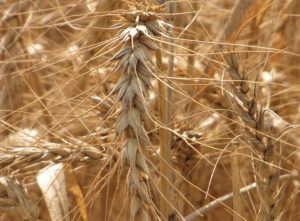Elana Shap | ISRAEL21c
A quarter of the world’s food comes from just one crop. It grows abundantly in Russia and Ukraine, but war has obstructed the supply chain.

Add to this the effects of climate change, and a major food crisis seems inevitable.
One solution could be lying in a seed collection housed in the Israel Plant Gene Bank of the Volcani Center Agricultural Research Organization near Tel Aviv.
“We have built up a collection of over 900 wheat lines. This is a massive and rich collection compared to banks in other parts of the world,” says Volcani researcher Sivan Frenkin. “It’s really a toolbox for the cultivation and improvement of future wheat varieties, to cope with climate change or crop diseases like wheat rust.”
Since the 1950s, wheat has been plentiful due to the cultivation of modern varieties that produce very high yields. Today, it is one of three staple foods (aside from rice and maize) and accounts for the nutrition and income of more than 4 billion people worldwide.
So where does the problem lie?
Despite its success in feeding the world, modern wheat lacks genetic diversity and is not resilient enough to withstand droughts, floods and pests. And this is where ancient wheat lines (landraces) from Israel have a distinct advantage.
A genetic treasure
“The Near East climate ranges from arid to Mediterranean, under which local wheat landraces have been grown for millennia, assumingly accumulating a unique repertoire of genetic adaptations,” states Frenkin, a Ph.D. candidate researching restoration of lost genetic diversity of wheat landraces from Israel.
Roi Ben David, director of agricultural research at the Volcani Center, concurs: “Israel is geographically sitting on a genetic treasure. These are wheat lines that go back to the beginning of agriculture where cultivation of wheat started.”
New wheat varieties could also counter the effects of the current disruption to the supply chain. The war in Ukraine, he estimates, has caused the loss of wheat equivalent to that consumed by 151 million people in an average year. Floods in India have also become a regular occurrence and in the past few seasons have seen large areas of wheat crops destroyed.
“The genetic variations will enable the improvement of wheat year to year to meet the growing demand,” explains Ben David.
The Volcani’s “Land of Wheat” initiative was set up by Ben David in 2015 together with the Plant Gene Bank under Einav Mayzlish-Gati and Bizi Goldberg, an independent consultant in the field of traditional wheat—the prime aim being to conserve, restore and characterize Israel’s local and traditional wheat varieties.
“We started from scratch,” says Ben David. “Past collections were fragmented and not taken care of, which put it at high risk. Over the last seven years, we have built up a very organized and diverse bank.”
One of the team’s initial tasks was to scour the databases of gene bank collections worldwide looking for landraces that had grown in ancient and traditional Israel agriculture. Detective work included finding collections that had samples with “names related to the traditional names of lines in our region and that we knew had been collected here,” explains Frenkin.
Some of the seeds located had been stored abroad for decades, including specimens brought back to Israel from St. Petersburg, where Russian seed bank founder Nikolai Vavilov had amassed a collection of ancient wheat seeds brought from his visit to Israel in 1926.
Other important specimens were found in institutions around the State of Israel and even in storage at Volcani itself.
Part of the latter, says Mayzlish-Gati, is one of the last collections conducted in the 1980s by the Volcani’s Yaakov Matitya.
His research was documented in little notebooks and covered trips he made throughout the country from the Golan Heights to the Sinai Desert. These seeds were moved to more optimum conditions at a temperature of minus-20 degrees.
Introducing Aviv
Once the collection was fully genotyped, it was then time to put the 900 samples to the test to “see what we have in our hands. It was exciting,” shares Frenkin.
Propagation was carried out during two seasons in two very different climactic regions: in Volcani’s net-houses in the center of the country with its Mediterranean climate; and at its Gilat Experimental Station in the semi-arid northern part of the Negev Desert.
Some lines, including a batch collected in the 1970s, didn’t succeed in germinating, but Frenkin is not disappointed.
“We cannot be nostalgic and think the past was much better than the present. The modern varieties are excellent cultivars and give high yields, sometimes double that to landraces. But they don’t have options for improvement. Our project will enrich the resource of genetic traits.”
The institute has engineered a wheat strain, named Aviv, with an ultra-short lifecycle. It flowers early in the cooler months of January and February to escape heat and possible drought later in the year. Not yet economically viable for farmers, Aviv has benefits for those cultivating wheat in dry climates.
Another strain that has been developed is Mizpor 37, a late-flowering variety that is more disease resistant and is suitable for animal feed.
Artisanal bread
Testing the flavor, texture and aroma of bread baked with promising ancient wheat strains is also part of the Land of Wheat project.
To that end, a baking and tasting panel was recently organized with four artisanal bakers and Stybel Flour Mills, one of the largest suppliers of flour in Israel.
One of the bakers, Hagay Ben Yehuda, says he was fortunate that his interest in ancient wheat strains Einkorn and Emmer (“the grandmother and grandfather of all the wheat in the world”) coincided with the Volcani wheat researchers’ outreach to bakers working with traditional methods.
Together with a farmer in the Galilee, Ben Yehuda has planted seeds of indigenous, ancient wheat strains obtained from the Volcani bank.
Ben Yehuda notes that ancient strains of wheat are low in gluten and high in minerals and vitamins. But his experience has not always been favorable.
“Emmer wheat had no interesting flavors and was disappointing. But Einkorn was a revolution of flavors that hits you with each bite.”
This is probably why his country-style bread, which mixes 30% Einkorn flour with both spelt and rye, is a favorite among his customers at Hagay Ve’ha-lehem (Hagay Bread) on Kibbutz Einav.
While it is invigorating to taste ancient wheat varieties, breeding new ones to face the immense challenges will take time, “10 years at the earliest,” predicts Ben David.
Elana Shap has covered a wide range of subjects for print and digital outlets in Israel and abroad, including “The Jerusalem Post,” “Jerusalem Report,” “The Forward” and Aish.com. Born in South Africa, she has lived in Israel since 1991.






